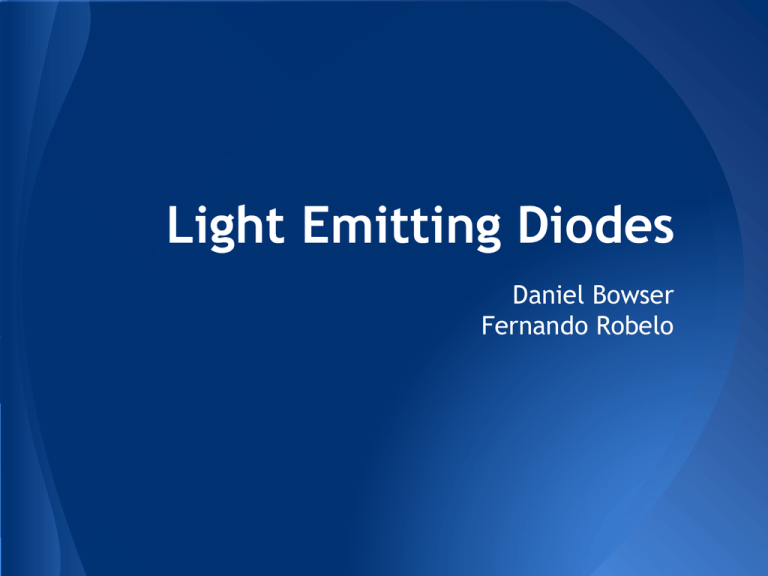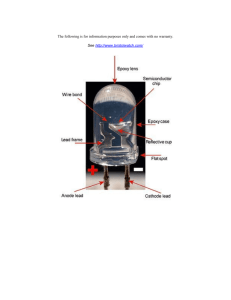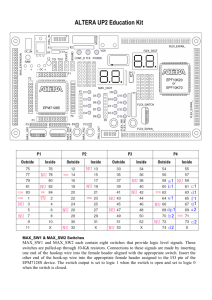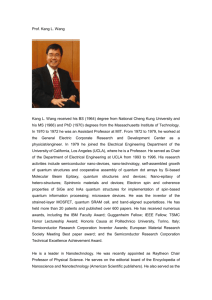Light Emitting Diodes (LEDs)
advertisement

Light Emitting Diodes Daniel Bowser Fernando Robelo Contents Basics of LEDs Current LED technology Band Gap Semiconductor Organic Frontier LED technology Quantum Dot Conclusions Basics of LEDs Light Emitting Diodes (LEDs) • Semiconductor based radiation source o photons emitted when electrons recombine with holes • Visible, Infrared, and Ultraviolet Emission Applications of LEDs Indicators and Signs Lighting street lights, aviation, display background, color changing, small durable devices, infrared emission, vehicle lighting Fiber optics Sustainable lighting energy, economical 3 Types of LEDs Current LED technology: Band Gap Semiconductor Ultraviolet and blue White Organic (OLEDs) Frontier Research: Quantum Dot (QdotLEDs) http://www.photonics.com/Article.aspx?AID=24915,http://www.arlty.com/faq/, http://en.wikipedia.org/wiki/Led Current LED Technology Band Gap Semiconductor Organic Frontier Research Quantum Dot Band Gap Semiconductor Based LEDs • First LED to be developed (1927) • Most widely used • Most economical to produce • p/n junction semiconductor • typically made of III/V compounds http://en.wikipedia.org/wiki/Category:III-V_compounds Band Gap Semiconductor Based LEDs p-n junction no voltage applied Band Gap Semiconductor Based LEDs p-n junction forward voltage bias Band Gap Semiconductor Based LEDs Unfortunately its not that simple... -modern LEDs do not use just one p-n junction composed of two materials -hundreds of p-n junctions between highly complex crystal structures -band gaps must be carefully engineered to produce light of the desired color Current LED Technology: Band Gap Semiconductor Organic Frontier Research Quantum Dot Organic LEDs LED that uses an organic semiconductor as the luminescent layer Thin, flexible, with some transparent components Broad applications in displays and mobile devices Magnified OLED phone display Organic LEDs http://www.circuit stoday.com/work ng-of-organicled-oled Organic LEDs Composition of small molecule OLED semiconductors Emissive Layer Organometallic chelates Fluorescent and Phosphorescent Dyes Conductive Layer Dendrimers for charge transport http://en.wikipedia.org/wiki/Organic_light-emitting_diode Current LED Technology Band Gap Semiconductor Organic Frontier Research Quantum Dot Uses of Colloidal Quantum Dots Photovoltaics Photodetectors Light Emitting Diodes Physical Structure of Qdot LED Electronic Structure of Qdot LED Purpose of Research To determine the ability to dramatically enhance quantum efficiency of exciton recombination by tuning distance between PbS quantum dots in active layer LED LED performance and interdot distance Current density-voltage characteristic Emission Spectra and infrared image of LEDs Qdot LED Advantages and Disadvantages Low cost and may be directly integrated Difficult to control exciton dissociation and recombination (unstable) Greater color range, as well as color accuracy 100 times brighter than LCD displays Greater flexibility and improve lifetime Conclusions Current LEDs compared to current lighting alternatives Advantages: more energy efficient longer lifetime wider range of applications Disadvantages: high initial price quality of light produced Future Research Competition between exciton dissociation an radiative recombination dominates the variation of EQE with different linker molecules Performance improvement are possible based on the understanding of the limitations of charge transport and injection rates can optimize LED efficiency and radiance References Primary paper being discussed: Bright infrared quantum-dot light-emitting diodes through inter-dot spacing control. http://www.nature.com/nnano/journal/v7/n6/abs/nnano.2012.63.htm l Other sources: http://onlinelibrary.wiley.com/doi/10.1889/1.2785443/abstract http://ieeexplore.ieee.org/xpls/abs_all.jsp?arnumber=6248162 http://onlinelibrary.wiley.com/doi/10.1889/1.3500495/abstract http://onlinelibrary.wiley.com/doi/10.1889/1.1927730/abstract http://photonics.intec.ugent.be/education/ivpv/res_handbook/v1ch1 2.pdf Questions?







